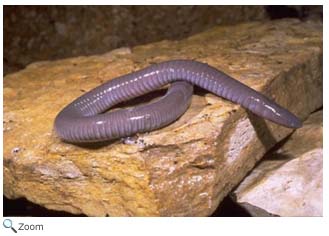Caeciliidae - Common Caecilians
|
|
|
|
 Common caecilians are found in Central America, South America, Africa, and India. Common caecilians are found in Central America, South America, Africa, and India.
Caecilians look like worms, eels, or snakes. Caecilians have no tail and their mouth is recessed under their snout. They have strong jaws and lots of teeth.
Caecilians have no gills, but they have gill slits. The bones in their skulls are fused into what looks like one solid helmet. They use their heads to burrow into leaf litter and into the ground.
Males and females look the same. Excepts for during the mating season, most caecilians are solitary. Caecilians eat insects, worms, and small snakes.
World Status Key
 Least Concern Least Concern  Near Threatened Near Threatened  Vulnerable Vulnerable  Endangered Endangered  Critically Endangered Critically Endangered  Extinct in Wild Extinct in Wild  Extinct Extinct
Status and range is taken from ICUN Redlist. If no status is listed, there is not enough data to establish status.
US Status Key
 Threatened in US Threatened in US  Threatened in NH Threatened in NH  Endangered in US Endangered in US  Endangered in NH Endangered in NH  Breeds N.H. Breeds N.H.  Introduced Introduced
Status taken from US Fish and Wildlife and NH Fish and Game
Location Key
 Africa Africa  Asia Asia  Australia Australia  Europe Europe  North America North America  South America South America  NH NH  Click for More Info Click for More Info  Click for Image Click for Image
Additional Information
Key:  Profile Profile  Photos Photos  Video Video  Audio Audio
Atretochoana eiselti   
Atretochoana eiselti is found in Brazil. Until 2011, it was only known from preserved specimens.
Source: AmphibiaWeb Intended Audience: General Reading Level: High School Teacher Section: No
Atretochoana eiselti   
Atretochoana eiselti can be up to 3 feet in length.
Source: Natural History Museum, UK Intended Audience: General Reading Level: Middle School Teacher Section: Yes
Boulengerula boulengeri    
Boulengerula boulengeri is found in Tanzania.
Source: AmphibiaWeb Intended Audience: General Reading Level: High School Teacher Section: No
Boulengerula changamwensis   
Boulengerula changamwensis is found in Kenya and Malawi.
Source: AmphibiaWeb Intended Audience: General Reading Level: High School Teacher Section: No
Boulengerula fischeri   
Boulengerula fischeri is found in Rwanda.
Source: AmphibiaWeb Intended Audience: General Reading Level: High School Teacher Section: No
Boulengerula niedeni    
Boulengerula niedeni is found in Kenya.
Source: AmphibiaWeb Intended Audience: General Reading Level: High School Teacher Section: No
Boulengerula niedeni    
Boulengerula niedeni has tow rows of teeth on each of its jaws.
Source: Arkive Intended Audience: General Reading Level: Middle School Teacher Section: Yes
Boulengerula taitana    
Boulengerula taitana is found in the Taita Hills in Kenya.
Source: AmphibiaWeb Intended Audience: General Reading Level: High School Teacher Section: No
Boulengerula uluguruensis    
Boulengerula uluguruensis is found in Tanzania.
Source: AmphibiaWeb Intended Audience: General Reading Level: High School Teacher Section: No
Caecilia attenuata   
Caecilia attenuata is found in Ecuador and Peru.
Source: AmphibiaWeb Intended Audience: General Reading Level: High School Teacher Section: No
Caecilia caribea   
Caecilia caribea is found in Colombia .
Source: AmphibiaWeb Intended Audience: General Reading Level: High School Teacher Section: No
Caecilia isthmica    
Caecilia isthmica is found in Colombia and Panama.
Source: AmphibiaWeb Intended Audience: General Reading Level: High School Teacher Section: No
Caecilia marcusi    
Caecilia marcusi is found in Bolivia.
Source: AmphibiaWeb Intended Audience: General Reading Level: High School Teacher Section: No
Caecilia nigricans     
Caecilia nigricans is found in Colombia, Ecuador, and Panama.
Source: AmphibiaWeb Intended Audience: General Reading Level: High School Teacher Section: No
Caecilia occidentalis   
Caecilia occidentalis is found in Colombia.
Source: AmphibiaWeb Intended Audience: General Reading Level: High School Teacher Section: No
Caecilia subnigricans    
Caecilia subnigricans is found in Colombia and Venezuela.
Source: AmphibiaWeb Intended Audience: General Reading Level: High School Teacher Section: No
Caecilia tentaculata    
Caecilia tentaculata is found in Brazil, Colombia, Ecuador, French Guiana, Peru, Suriname, and Venezuela.
Source: AmphibiaWeb Intended Audience: General Reading Level: High School Teacher Section: No
Caecilia thompsoni   
Caecilia thompsoni is found in Colombia.
Source: AmphibiaWeb Intended Audience: General Reading Level: High School Teacher Section: No
Caecilia thompsoni  
Caecilia thompsoni can be up to 5 feet in length.
Source: Arkive Intended Audience: General Reading Level: Middle School Teacher Section: Yes
Chthonerpeton indistinctum    
Chthonerpeton indistinctum is found in Argentina, Brazil, Paraguay, and Uruguay.
Source: AmphibiaWeb Intended Audience: General Reading Level: High School Teacher Section: No
Mexican Caecilian - Dermophis mexicanus    
The Mexican Caecilian is found in El Salvador, Guatemala, Honduras, Mexico, and Nicaragua.
Source: AmphibiaWeb Intended Audience: General Reading Level: High School Teacher Section: No
Mexican Caecilian - Dermophis mexicanus    
The Mexican Caecilian eats termites, crickets, snails, slugs, and earthworms.
Source: DigiMorph Intended Audience: General Reading Level: High School Teacher Section: No
Mexican Caecilian - Dermophis mexicanus   
The Mexican Caecilian is 11-19 inches in length.
Source: Arkive Intended Audience: General Reading Level: Middle School Teacher Section: Yes
Dermophis oaxacae   
Dermophis oaxacae is found in Mexico.
Source: AmphibiaWeb Intended Audience: General Reading Level: High School Teacher Section: No
Dermophis occidentalis   
Dermophis occidentalis is found in Costa Rica.
Source: AmphibiaWeb Intended Audience: General Reading Level: High School Teacher Section: No
Dermophis parviceps    
Dermophis parviceps is found in Costa Rica and Panama.
Source: AmphibiaWeb Intended Audience: General Reading Level: High School Teacher Section: No
Gegeneophis carnosus   
Gegeneophis carnosus is found in India.
Source: AmphibiaWeb Intended Audience: General Reading Level: High School Teacher Section: No
Gegeneophis carnosus  
Gegeneophis carnosus lives in humid evergreen forests.
Source: Arkive Intended Audience: General Reading Level: Middle School
Gegeneophis danieli   
Gegeneophis danieli is found in India.
Source: AmphibiaWeb Intended Audience: General Reading Level: High School Teacher Section: No
Gegeneophis goaensis   
Gegeneophis goaensis is found in India.
Source: AmphibiaWeb Intended Audience: General Reading Level: High School Teacher Section: No
Gegeneophis mhadeiensis   
Gegeneophis mhadeiensis is found in India.
Source: AmphibiaWeb Intended Audience: General Reading Level: High School Teacher Section: No
Gegeneophis seshachari   
Gegeneophis seshachari is found in India.
Source: AmphibiaWeb Intended Audience: General Reading Level: High School Teacher Section: No
Geotrypetes seraphini    
Geotrypetes seraphini is found in India.
Source: AmphibiaWeb Intended Audience: General Reading Level: High School Teacher Section: No
Gymnopis multiplicata    
Gymnopis multiplicata is found in Costa Rica, Guatemala, Honduras, Nicaragua, and Panama.
Source: AmphibiaWeb Intended Audience: General Reading Level: High School Teacher Section: No
Indotyphlus battersbyi   
Indotyphlus battersbyi is found in India.
Source: AmphibiaWeb Intended Audience: General Reading Level: High School Teacher Section: No
Indotyphlus maharashtraensis   
Indotyphlus maharashtraensis is found in India.
Source: AmphibiaWeb Intended Audience: General Reading Level: High School Teacher Section: No
Microcaecilia taylori    
Microcaecilia taylori is found in Suriname.
Source: AmphibiaWeb Intended Audience: General Reading Level: High School Teacher Section: No
Oscaecilia osae   
Oscaecilia osae is found in Costa Rica.
Source: AmphibiaWeb Intended Audience: General Reading Level: High School Teacher Section: No
Oscaecilia osae   
Oscaecilia osae is up to 15 inches in length.
Source: Species of Costa Rica Intended Audience: General Reading Level: In Spanish Teacher Section: No
Oscaecilia polyzona   
Oscaecilia polyzona is found in Colombia .
Source: AmphibiaWeb Intended Audience: General Reading Level: High School Teacher Section: No
Potomotyphlus kaupii    
Potomotyphlus kaupii is found in Brazil, Colombia, Ecuador, Peru, and Venezuela.
Source: AmphibiaWeb Intended Audience: General Reading Level: High School Teacher Section: No
Schistometopum gregorii    
Schistometopum gregorii is found in Kenya and Tanzania.
Source: AmphibiaWeb Intended Audience: General Reading Level: High School Teacher Section: No
Schistometopum thomense    
Schistometopum thomense is found on the island nation of Sao Tomé and Principe off the coast of Africa.
Source: AmphibiaWeb Intended Audience: General Reading Level: High School Teacher Section: No
Scolecomorphus vittatus    
Scolecomorphus vittatus is found in Tanzania.
Source: AmphibiaWeb Intended Audience: General Reading Level: High School Teacher Section: No
Ringed Caecilian - Siphonops annulatus    
The ringed caecilian is found in Argentina, Bolivia, Brazil, Colombia, Ecuador, French Guiana, Guyana, Paraguay, Peru, Suriname, and Venezuela.
Source: AmphibiaWeb Intended Audience: General Reading Level: High School Teacher Section: No
Siphonops paulensis    
Siphonops paulensis is found in Argentina, Bolivia, Brazil, and Paraguay.
Source: AmphibiaWeb Intended Audience: General Reading Level: High School Teacher Section: No
Sylvacaecilia grandisonae  
Sylvacaecilia grandisonae is found in Ethiopia.
Source: Arkive Intended Audience: General Reading Level: Middle School Teacher Section: Yes
Typhlonectes compressicauda    
Typhlonectes compressicauda is found in Brazil, Colombia, French Guiana, Guyana, Peru, and Venezuela.
Source: AmphibiaWeb Intended Audience: General Reading Level: High School Teacher Section: No
Typhlonectes natans    
Typhlonectes natans is found in Colombia and Venezuela.
Source: AmphibiaWeb Intended Audience: General Reading Level: High School Teacher Section: No
Typhlonectes natans    
Typhlonectes natans is also known as the rubber eel, but it is not an eel.
Source: DigiMorph Intended Audience: General Reading Level: High School Teacher Section: No
Typhlonectes natans    
Typhlonectes natans is 17-21 inches in length.
Source: World Association of Zoos and Aquariums Intended Audience: General Reading Level: Middle School Teacher Section: No |

